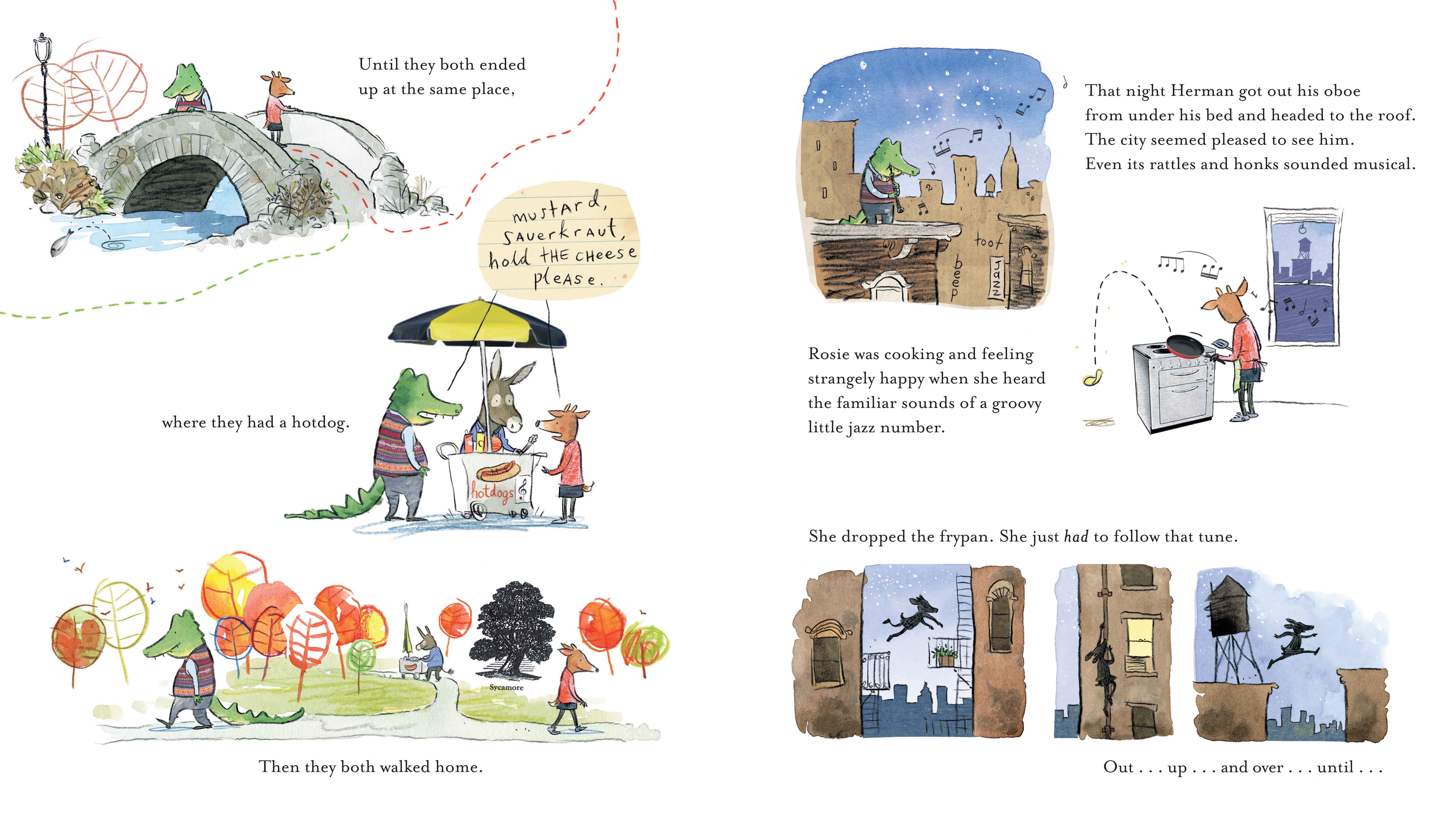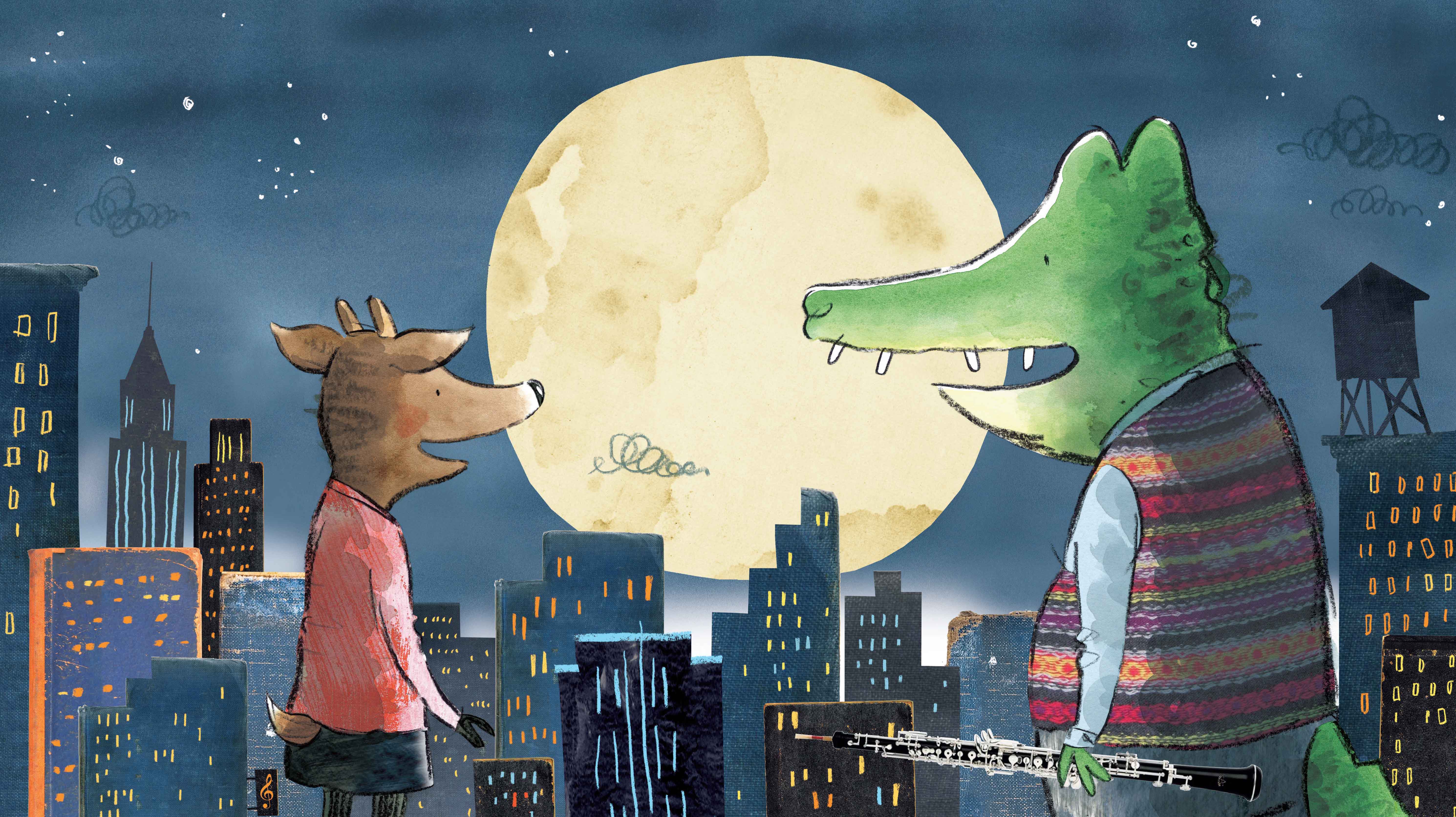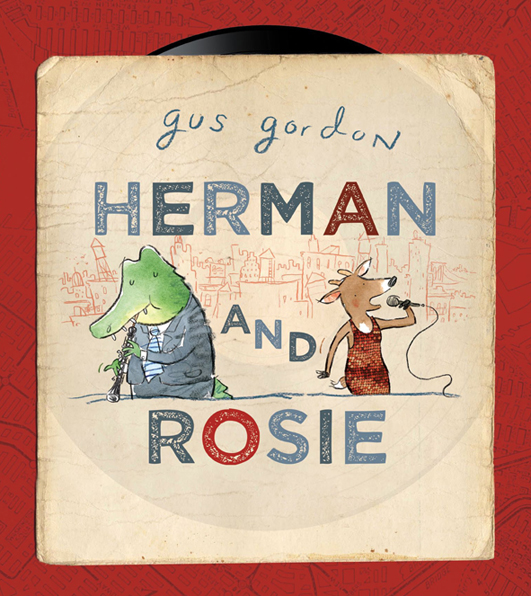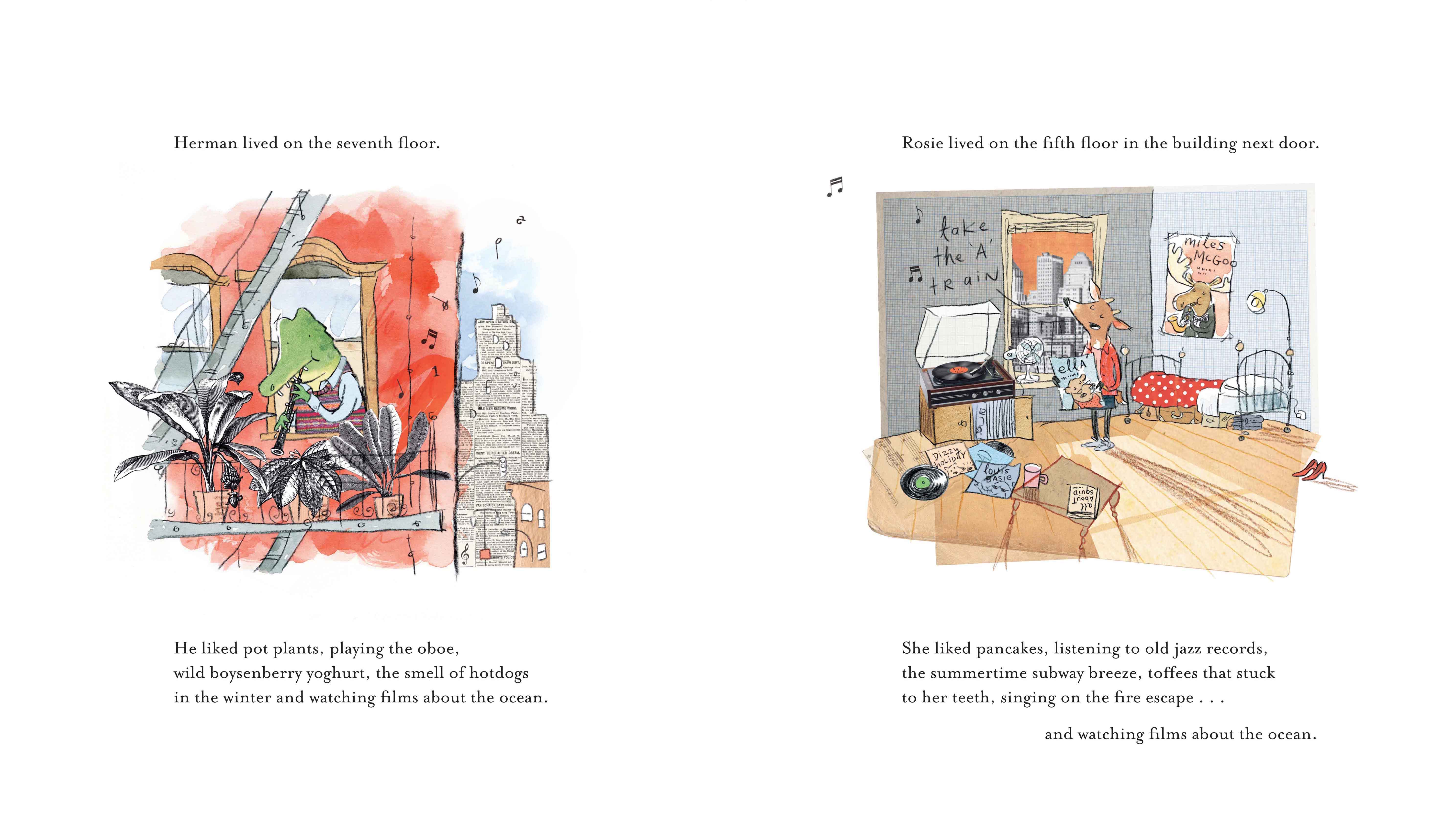Even though hundreds of character-driven picture books are published every year, great ones are still a relatively rare thing. They need a likable/relatable main character, a compelling story, emotional resonance, a distinctive voice, etc., etc., etc. It’s only occasionally that lo, those many elements magically mesh to create something special.
So how about that rarest of birds, a well-written picture book story with TWO characters driving the plot? Enter Herman and Rosie, a friendship story by author-illustrator Gus Gordon.
This type of story requires a masterful balancing act. Gordon has to give us enough information about each character that we immediately know who they are – and care. But not so much that either takes over the story. Here’s the spread that blew me away (click to enlarge).
He liked potted plants, playing the oboe, wild boysenberry yogurt, the smell of hot dogs in the winter, and watching films about the ocean.
On the right, Rosie:
She liked pancakes, listening to old jazz records, the summertime subway breeze, toffees that stuck to her teeth, singing on the fire escape … and watching films about the ocean.
Only 53 words here to characterize these two quirky souls, just enough that – wait a minute! – our minds are immediately making a connection: Hmmm, they both like music and films about the ocean. See how Gordon did that? Made us start linking them inside our heads? Then he drives us crazy as they keep coming oh, so close to meeting, but–
I’m not going to review the entire story – which, take my word for it, is lovely – but since Gus illustrated my I Am Cow, Hear Me Moo!, and I know him (virtually, anyway, at least until Penguin decides to send me on an Australian book tour not holding my breath), I thought I’d go straight to the source and ask him a few questions about creating this book. You are in for a treat, peeps. And rare insight.
Jill: Writing a book with two main characters seems as though it would be restrictive. After all, you have only half the word count and actual physical page space to devote to developing each character. Yet this story never feels as though you’re limiting yourself. What sorts of challenges did you encounter while working out the story details of this book?
Gus: Thanks for the kind words about Herman and Rosie, Jill. Yes, writing a dual narrative was a crazy challenge and there were many times To be honest where I felt that I didn’t have the writing chops to pull it off – still don’t know that I did. In fact, when I realised that the story required the writing of two equally balanced narratives I was immediately taken with a sense of dread. In order to make the story work I knew I had to somehow figure out a way to way to tell two stories side by side so that the cadence felt smooth and it wasn’t confusing as I jumped back and forth between Herman and Rosie’s stories. I decided early on that the way to do this was to make sure that the two were connected in some way – in a way that wasn’t overly convenient but reflected the character’s personalities. Having interests in common, namely their love of music, really helped I think. Music was definitely the glue.
At the beginning I needed to introduce the characters very quickly as I didn’t have the normal room to introduce the characters to the reader given I was telling two stories essentially and also because I had decided, rather unusually I suppose, to begin the story from the perspective of the city – the environment in which the characters lived. To do this effectively I chose to describe their personalities in a list-like fashion – almost in point form, rather like you might see on a dating site (so I’m told). I actually stole this idea from one of my favourite movies, the French film Amélie. In the opening monologue of the film, the narrator lists the likes and dislikes of the main characters:
Raphaël Poulain doesn’t like peeing next to somebody else.
He doesn’t like noticing people laughing at his sandals,
… coming out of the water with his swimming suit sticking to his body.
Raphaël Poulain likes to tear big pieces of wallpaper off the walls,
… to line up his shoes and polish them with great care
… to empty his toolbox, clean it thoroughly, and, finally, put everything away carefully.
Amélie’s mother, Amandine Fouet, was a Primary School teacher from Gueugnon.
She had always been unstable and nervy.
She doesn’t like to have her fingers all wrinkled by hot water.
She doesn’t like it when somebody she doesn’t like touches her,
… to have the marks of the sheets on her cheek in the morning.
She likes the outfits of the ice-skaters on TV,
… to shine the flooring,
… to empty her handbag clean it thoroughly, and, finally, putting everything away carefully.
This is just a snippet of it but I loved how focused, and obsessive, and quirky each of the likes and dislikes are. You get an instant sense of the person, as peculiar as they might be. On a side note, a writer mate of mine (Markus Zusak) reckons there’s a hundred stories in that opening.
Anyway, this way of getting to know the characters seemed to suit my story, especially as I needed to condense their introductions somewhat. It was a nice way to set it all up and it helped paint them in an endearing light, albeit slightly idiosyncratic. Now I could get on with the business of telling the story.
Throughout the story I was very conscious of symmetry. I didn’t want Herman nor Rosie’s story to outweigh the other. I was careful to make sure that the reader didn’t empathise with one over the other either, even if it was subtle. Every moment was agonisingly considered. I wanted the reader to recognise that the characters were leading parallel lives, good and bad, and that hopefully the tension was enough that they felt compelled to read on in the hope that Herman and Rosie’s worlds would eventually come together (which of course was always going to happen). In a sense, the rooftop meeting was the reader’s reward.
Jill: Was devising the physical layout of this story challenging – deciding which scenes needed full spreads, for instance, or where you had to condense – to control the story’s pacing? Or does that come instinctively, at this point in your career?
Gus: Nothing really comes instinctively in picture books – at least, not for me. Every time I think I have something worked out I hit a wall and need to find another angle to approach the problem. Picture book making is basically problem solving isn’t it.
I did so many storyboards for this book. Thankfully I had a lot of help from my editor at Penguin, Katrina Lehman. It’s a constant battle working out what I should say in the text, verse what I should show in the illustrations.
Beginning with the map of New York city in the endpapers, I then (kind of like Google Earth) panned in to a full spread of the city and then focused in on the characters and their stories. It’s a frustratingly tricky process, (please, just give me one more page!!) trying to work out the story’s pacing and find enough room for everything. Once I’d established that they lived close to each other and that they could potentially bump into each other at some point, I pulled them apart teasingly, giving them their own full spreads and revealing a little more of their personalities. At this point, having heard each other, but importantly not having seen each other, I felt it would be fun to tantalisingly bring Herman and Rosie close together again, so I opted for small vignettes to tease the reader and build the tension. Using small vignettes are a good way of telling story quickly in those moments that are key to the story but aren’t pivotal, whereas a full page or double are reserved for an occasion in the story that requires more gravity; where you may need to pause a little to take it in.
 For me, the moment when they finally meet needed to be perfect. It had to echo both their journeys in a tremendously satisfying way. That was the goal anyway. I was also set on this spread being wordless, quiet; like the city has paused to honour the occasion – a real ‘oh’ moment. I wanted the reader to feel enormously sated – like they helped unite Herman and Rosie in some way (you can see how much thought I’ve put into such things. A scary amount of over-thinking too!)
For me, the moment when they finally meet needed to be perfect. It had to echo both their journeys in a tremendously satisfying way. That was the goal anyway. I was also set on this spread being wordless, quiet; like the city has paused to honour the occasion – a real ‘oh’ moment. I wanted the reader to feel enormously sated – like they helped unite Herman and Rosie in some way (you can see how much thought I’ve put into such things. A scary amount of over-thinking too!)

Jill: I wanted to ask about your illustration style, but my grasp of art lingo wouldn’t fill a 2 x 2 sticky note, so I asked my blogmate, illustrator Jennifer Black Reinhardt, what she’d most like to ask you.
Jennifer: When did you start using mixed media and why does it appeal to you? Do you see all the layers in your illustration from the beginning and set off with a plan? Or is it something that just builds and morphs as you go?
Gus: I started using mixed media years ago but it’s only been in the last five or so years that I’ve used it with any confidence. The thing I love about collage is what it offers in the way of helping to tell story. Unlike other mediums it has the ability to contribute to the storytelling. Used cleverly it can add layers of narrative, both visually and contextually and thereby strengthening the overall narrative. As long it’s weaved seamlessly within the pages and doesn’t distract the reader from the story. That’s the tricky part. The last thing you want is the collage to pull everything apart.
Generally speaking I start out with a plan. I usually try and seek out collage that relates appropriately with the theme/s of the story. Maps, paper, old advertisements, postcards, vintage engravings that speak to the theme. I really enjoy sourcing all my materials and when I have something particular in mind I have to find it. Aside from anything, good collage is a visual treat for the reader to take in over and over.
Jill: One last question that kids ask me at school visits: Why do books published in the U.S. with one cover often have a different cover when published in another country? (Note to readers: Because the U.S. cover of I Am Cow, Hear Me Moo! is very different from the Australia/NZ cover.)
Gus: Beats me! I’m told that it’s always about catering to a publishers market – to the people who buy books in that country. Sometimes, as you know, there doesn’t seem to be any logic to it. I think some publishers like to change the cover because they can. But who am I to judge!



What a fabulous post. I got this book out of my local Melbourne library just a few weeks ago and absolutely loved it. Every page felt like it could become a print on my wall. The story was so lovely and you nailed the pacing Mr Gordan. Thanks for a fantastic example, to this aspiring picture book author.
Glad you enjoyed it, Julie. Good luck with your writing!
What a special way to meet. Exaggeration made fun! I loved it. Thanks so much for the interview and look into the makings of story.
Thanks, Linda. I love reminders that creating picture books is a process – and not just for us writers.
Wow, I have an illustrative crush on Gus Gordon. Great post, Jill. I really enjoyed what he said about the challenges of balancing the symmetry between the characters. Really interesting, thank you!
You’re very welcome, Jennifer. And thanks for knowing what to ask about the illustrations!
Fascinating insight into merging playful, character-driven characters (2!) with mixed media. Only spotted newsprint buildings in the background but would love to get the book to discover more, since I love to study and employ this illustration technique.
Yes, definitely get your hands on a copy, Elaine. Feels like a treasure hunt to uncover those little unexpected tidbits on each page. Heck, I’m still finding surprises in the collages Gus created for I Am Cow, Hear Me Moo!
As you know, Jill, I love this book, so what a treat to meet its creator! Terrific interview — I love hearing about how creative people approach their work. Thanks for introducing us to Gus (and thanks for visiting, Gus!). But you need a link to your fabulous new collaboration: I AM COW, HEAR ME MOO.
Oops! Thanks for the reminder, Linda. Done. And you’re welcome. 🙂
Just finished reading Zombie in Love loved it! Now on to Herman & Rosie. Thanks for the insight to great picture books! Keep’ m coming!
Will do, Emma! 😉
Wonderful book, wonderful interview! I love that Amelie was inspiration for the opening!!
I know! Goes to show that you never know what will inspire a pb idea. 🙂
What a fabulous interview! It is such a great treat to read of Mr. Gordon’s process..thank you so much and Congratulations on your book! I am off to add this to my collection. 🙂
Thanks, Shirley. I know you’ll love it.
I love Herman and Rosie! Lovable characters, great pacing and amazing illustrations. Thank you, Jill and Mr. Gordon for an insightful interview.
You’re very welcome, Liz.
Thanks, Jill. I love, love, love reading about the journey. Inspiring! I also am rather taken with Herman’s vest. I’m off to purchase this book now.
Great! (And good luck with Little Louie!)
Thank you!
Great and post, Jill! And so timely for me since I’m working on a manuscript that has two characters driving the plot. The bulk of the story feels balanced, but I’m struggling with the satisfying ending. Time to study Herman & Rosie! Any other books that you suggest I look at?
Yes, and I’m struggling to write coherently, too. *Great post, Jill!*
Thanks, Patty. You’ve probably seen Boy + Bot? Nugget & Fang? Maybe readers will come up with others that are slipping my mind right now (6:16 a.m.)….
Thanks, Jill! I’ll pull Nugget & Fang off my shelves. Didn’t think of Boy + Bot. The ampersand (or plus) in the title is a big hint, isn’t it?
Fascinating post – GOTTA read this one. Love the interview too – THANKS!
Thanks for reading, Joanne!
Wow! Thank you, Jill and Gus. This was awesome and unbelievably timely since I just started a new picture book recently where I am alternating viewpoints between characters. Exciting and helpful to hear Gus’s process–I’m so grateful!
Terrific, Denise! Good luck with yours. 🙂
Hi all,
Just read all your nice comments. I enjoyed answering Jill’s questions and it’s always fun to talk about process. Everyone works so differently and, like everyone, I have moments where I have no idea what I’m doing. Often the only solution is sitting down and nutting it out until something clicks. Chuffed if I’ve helped anyone at all.
Best, Gus
Gus, I can’t speak for all writers, but I NEED an occasional reminder that none of us are alone in those “uh-oh, I’m lost” moments. THANKS for giving us a peek into your process. Fascinating stuff.
I absolutely LOVE this book! I adore the characters, and the art is beautiful and touching. It’s a lovely homage to NYC too!
DItto, Maria! 🙂